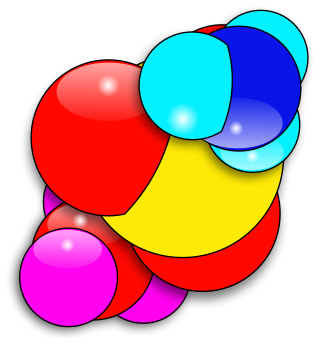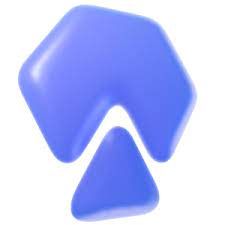GROningen MOlecular Simulation (GROMOS) is the name of a force field for molecular dynamics simulation, and a related computer software package. Both are developed at the University of Groningen, and at the Computer-Aided Chemistry Group at the Laboratory for Physical Chemistry at the Swiss Federal Institute of Technology (ETH Zurich). At Groningen, Herman Berendsen was involved in its development.

Folding@home is a distributed computing project aimed to help scientists develop new therapeutics for a variety of diseases by the means of simulating protein dynamics. This includes the process of protein folding and the movements of proteins, and is reliant on simulations run on volunteers' personal computers. Folding@home is currently based at the University of Pennsylvania and led by Greg Bowman, a former student of Vijay Pande.

Molecular mechanics uses classical mechanics to model molecular systems. The Born–Oppenheimer approximation is assumed valid and the potential energy of all systems is calculated as a function of the nuclear coordinates using force fields. Molecular mechanics can be used to study molecule systems ranging in size and complexity from small to large biological systems or material assemblies with many thousands to millions of atoms.
General-purpose computing on graphics processing units is the use of a graphics processing unit (GPU), which typically handles computation only for computer graphics, to perform computation in applications traditionally handled by the central processing unit (CPU). The use of multiple video cards in one computer, or large numbers of graphics chips, further parallelizes the already parallel nature of graphics processing.

Compute Unified Device Architecture (CUDA) is a proprietary parallel computing platform and application programming interface (API) that allows software to use certain types of graphics processing units (GPUs) for accelerated general-purpose processing, an approach called general-purpose computing on GPUs (GPGPU). CUDA API and its runtime: The CUDA API is an extension of the C programming language that adds the ability to specify thread-level parallelism in C and also to specify GPU device specific operations (like moving data between the CPU and the GPU). CUDA is a software layer that gives direct access to the GPU's virtual instruction set and parallel computational elements for the execution of compute kernels. In addition to drivers and runtime kernels, the CUDA platform includes compilers, libraries and developer tools to help programmers accelerate their applications.
This is a list of computer programs that are predominantly used for molecular mechanics calculations.
TRACE is a connectionist model of speech perception, proposed by James McClelland and Jeffrey Elman in 1986. It is based on a structure called "the TRACE," a dynamic processing structure made up of a network of units, which performs as the system's working memory as well as the perceptual processing mechanism. TRACE was made into a working computer program for running perceptual simulations. These simulations are predictions about how a human mind/brain processes speech sounds and words as they are heard in real time.
Acceleware Ltd. is a Canadian innovator of clean-tech oil and gas technologies composed of two business units: Radio Frequency (RF) Enhanced Oil Recovery and Seismic Imaging Software. The company is currently running a commercial-scale, RF XL pilot project at Marwayne, Alberta, Canada, to advance and validate its heavy oil and oil sands electrification technology. Acceleware's seismic imaging software solutions offer imaging for oil exploration in complex geologies.

Molecular modeling on GPU is the technique of using a graphics processing unit (GPU) for molecular simulations.
OpenMM is a library for performing molecular dynamics simulations on a wide variety of hardware architectures. First released in January 2010, it was written by Peter Eastman at the Vijay S. Pande lab at Stanford University. It is notable for its implementation in the Folding@home project's core22 kernel. Core22, also developed at the Pande lab, uses OpenMM to perform protein dynamics simulations on GPUs via CUDA and OpenCL. During the COVID-19 pandemic, a peak of 280,000 GPUs were estimated to be running OpenMM via core22.

AutoDock is a molecular modeling simulation software. It is especially effective for protein-ligand docking. AutoDock 4 is available under the GNU General Public License. AutoDock is one of the most cited docking software applications in the research community. It is used by the FightAIDS@Home and OpenPandemics - COVID-19 projects run at World Community Grid, to search for antivirals against HIV/AIDS and COVID-19. In February 2007, a search of the ISI Citation Index showed more than 1,100 publications had been cited using the primary AutoDock method papers. As of 2009, this number surpassed 1,200.
TeraChem is a computational chemistry software program designed for CUDA-enabled Nvidia GPUs. The initial development started at the University of Illinois at Urbana-Champaign and was subsequently commercialized. It is currently distributed by PetaChem, LLC, located in Silicon Valley. As of 2020, the software package is still under active development.
Local elevation is a technique used in computational chemistry or physics, mainly in the field of molecular simulation. It was developed in 1994 by Huber, Torda and van Gunsteren to enhance the searching of conformational space in molecular dynamics simulations and is available in the GROMOS software for molecular dynamics simulation. The method was, together with the conformational flooding method, the first to introduce memory dependence into molecular simulations. Many recent methods build on the principles of the local elevation technique, including the Engkvist-Karlström, adaptive biasing force, Wang–Landau, metadynamics, adaptively biased molecular dynamics, adaptive reaction coordinate forces, and local elevation umbrella sampling methods. The basic principle of the method is to add a memory-dependent potential energy term in the simulation so as to prevent the simulation to revisit already sampled configurations, which leads to the increased probability of discovering new configurations. The method can be seen as a continuous variant of the Tabu search method.
Martini is a coarse-grained (CG) force field developed by Marrink and coworkers at the University of Groningen, initially developed in 2004 for molecular dynamics simulation of lipids, later (2007) extended to various other molecules. The force field applies a mapping of four heavy atoms to one CG interaction site and is parametrized with the aim of reproducing thermodynamic properties.

Simon E. Fisher is a British geneticist and neuroscientist who has pioneered research into the genetic basis of human speech and language. He is a director of the Max Planck Institute for Psycholinguistics and Professor of language and genetics at the Donders Institute for Brain, Cognition and Behaviour in Nijmegen, The Netherlands.
Mario Barbatti is a Brazilian physicist, computational theoretical chemist, and writer. He is specialized in the development and application of mixed quantum-classical dynamics for the study of molecular excited states. He is also the leading developer of the Newton-X software package for dynamics simulations. Mario Barbatti held an A*Midex Chair of Excellence at the Aix Marseille University between 2015 and 2019, where he is a professor since 2015.
In the context of chemistry and molecular modelling, the Interface force field (IFF) is a force field for classical molecular simulations of atoms, molecules, and assemblies up to the large nanometer scale, covering compounds from across the periodic table. It employs a consistent classical Hamiltonian energy function for metals, oxides, and organic compounds, linking biomolecular and materials simulation platforms into a single platform. The reliability is often higher than that of density functional theory calculations at more than a million times lower computational cost. IFF includes a physical-chemical interpretation for all parameters as well as a surface model database that covers different cleavage planes and surface chemistry of included compounds. The Interface Force Field is compatible with force fields for the simulation of primarily organic compounds and can be used with common molecular dynamics and Monte Carlo codes. Structures and energies of included chemical elements and compounds are rigorously validated and property predictions are up to a factor of 100 more accurate relative to earlier models.






